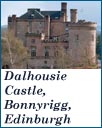Castle Hotels of Scotland—Lothians
Haven’t decided on a hotel yet? You can look at other available hotels in the Lothians region with Booking.com.
Dominated by the noble capital city of Edinburgh, the Lothians (made up of West Lothian, Midlothian, and East Lothian) is a region filled with castles, historic houses, beaches, green hills and fields.
The best way to see the area is to pick a base and make day trips. With decent public transportation, everything is within reach. And if you do have a car, one of the awesome castle hotels in the area will be the perfect place to come home to (besides having free parking).
Some great reasons to visit
![]() Edinburgh The capital of Scotland, Edinburgh boasts world-famous summer festivals and an incredible concentration of historic sights along its Royal Mile, including:
Edinburgh The capital of Scotland, Edinburgh boasts world-famous summer festivals and an incredible concentration of historic sights along its Royal Mile, including:
Edinburgh Castle The first fortress was erected here in the 6th century, but today’s castle is an assemblage of 12th- to 20th-century buildings, reflecting its role as fortress, royal palace, and military garrison. Highlights include the 15th-century Great Hall, and the palace where the Scottish Stone of Destiny and the Crown Jewels are displayed. The 12th-century St. Margaret’s Chapel is the oldest structure in Edinburgh
The Palace of Holyroodhouse At the far end of the Royal Mile, the Palace of Holyroodhouse is the official Scottish residence of Queen Elizabeth II. When the Queen isn’t in residence, the Throne Room and Royal Dining room are open to the public.
Outstanding Museums:
National Gallery of Scotland Small but works are well chosen from 15th- to 19th-century British and European masterpieces.
National Museum of Scotland Displays of decorative arts, ethnography, archaeology, and natural history tell the story of 1000s of years of Scottish history.
Monuments of Carlton Hill Visit the hill not only for the monuments (the Nelson Monument is dedicated to the hero of the Battle of Trafalgar, and the Lincoln Monument honors those of Scottish descent who perished in the American Civil War) but for the scenic view of the Firth of Forth.
Royal Botanic Garden This 70-acre (28 hectares) garden is considered one of the finest in Great Britain. It is especially famed for its rhododendron walk and Chinese garden, with the largest collection of wild-origin Chinese plants outside of China.
![]() Blackness Castle Looking much like a galleon grounded on the banks of the firth, 14th-century Blackness Castle was one of only four castles to be garrisoned in Scotland. A more modern use was as a backdrop in Mel Gibson’s film of Hamlet.
Blackness Castle Looking much like a galleon grounded on the banks of the firth, 14th-century Blackness Castle was one of only four castles to be garrisoned in Scotland. A more modern use was as a backdrop in Mel Gibson’s film of Hamlet.
![]() Tantallon Castle Dramatically situated on a cliff and surrounded by the sea on three sides and a moat on the fourth side, the ruins of this 14th-century, windswept and brooding castle are terrific to explore. The castle was a former stronghold of the Douglas family, the earls of Angus, one of Scotland’s foremost families. Cromwell finally destroyed the castle after a twelve-day bombardment.
Tantallon Castle Dramatically situated on a cliff and surrounded by the sea on three sides and a moat on the fourth side, the ruins of this 14th-century, windswept and brooding castle are terrific to explore. The castle was a former stronghold of the Douglas family, the earls of Angus, one of Scotland’s foremost families. Cromwell finally destroyed the castle after a twelve-day bombardment.
![]() Linlithgow Palace One of the most visited ruins in Scotland, Linlithgow Palace was the birthplace of Mary Queen of Scots in 1542. The majority of the palace was constructed by her father, James V. Hanoverians burned the castle in 1746, leaving a shell of a once magnificent structure.
Linlithgow Palace One of the most visited ruins in Scotland, Linlithgow Palace was the birthplace of Mary Queen of Scots in 1542. The majority of the palace was constructed by her father, James V. Hanoverians burned the castle in 1746, leaving a shell of a once magnificent structure.
![]() Leith Besides the medieval streets, historic warehouses, merchants houses, and quays of Edinburgh’s port, Leith is also home of the former British Royal Yacht Britannia.
Leith Besides the medieval streets, historic warehouses, merchants houses, and quays of Edinburgh’s port, Leith is also home of the former British Royal Yacht Britannia.
![]() Hopetoun House is one of Scotland’s most stately, grand mansions. Surrounding parkland reminiscent of Versailles merely provides a background to the dignified 18th-century, Neo-Classical architecture. Hopetoun House is home to the Marquess of Linlithgow.
Hopetoun House is one of Scotland’s most stately, grand mansions. Surrounding parkland reminiscent of Versailles merely provides a background to the dignified 18th-century, Neo-Classical architecture. Hopetoun House is home to the Marquess of Linlithgow.
![]() Rosslyn Chapel Dedicated to Saint Matthew in 1446, exquisite carvings of animals, plants, and human figures adorn the interior; some symbols are attributed to the Free Masons the Knights Templars. More recently, crowds come for Rosslyn Chapel’s controversial appearance in Dan Brown’s The Da Vinci Code.
Rosslyn Chapel Dedicated to Saint Matthew in 1446, exquisite carvings of animals, plants, and human figures adorn the interior; some symbols are attributed to the Free Masons the Knights Templars. More recently, crowds come for Rosslyn Chapel’s controversial appearance in Dan Brown’s The Da Vinci Code.


